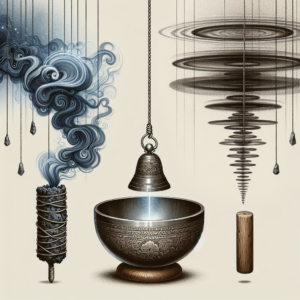
Key Takeaways
-
Understand the significance of pendulums in dowsing and energy balancing.
-
Learn to choose a pendulum based on material, shape, weight, and size for optimal energy work.
-
Discover how to cleanse and program your pendulum to align with your intentions.
-
Gain practical tips for selecting your first pendulum and developing a relationship with it.
-
Get answers to frequently asked questions about pendulum dowsing for beginners.
Finding Your Balance: Your First Pendulum for Energy Work
So, you’re interested in energy balancing and you’ve heard that a pendulum could be your ally in this journey. That’s a fantastic start! Energy balancing is all about restoring harmony in your life and environment, and a pendulum is a simple yet profound tool that can help you tap into your intuition and the energies around you. Let’s dive into the art of selecting the perfect pendulum for your energy work.
Defining Dowsing and its Connection to Pendulums
Dowsing, at its core, is a method used to gain information that isn’t readily available to our standard senses. Think of it as a way to listen to a deeper wisdom that lies within and around us. A pendulum is often the tool of choice for dowsers because it acts as a physical indicator of subtle energies and inner knowledge. When you ask a question, the pendulum’s swing is believed to be influenced by your subconscious mind and the energy flows that you’re trying to sense or balance.
Why Pendulums are Key in Energy Balancing
Pendulums are more than just pretty crystals on a chain. They are a key that unlocks communication with the subconscious mind and the universal energy that we are all a part of. Whether you’re looking for guidance, seeking to make a decision, or aiming to balance chakras, a pendulum can provide clear and immediate feedback. It’s a bridge between the seen and unseen, helping you to understand and influence your personal energy flow and that of your surroundings.
Material Matters: Choosing a Pendulum That Resonates
Now, let’s talk materials. Just like choosing a wand in the world of wizardry, selecting a pendulum is a personal affair. The material of your pendulum is not just about looks; it’s about the connection and the energy it carries.
Crystal Compositions and Their Energetic Properties
Crystals are popular choices for pendulums because they are believed to have their own energies which can align with different intentions. Here’s a quick rundown:
-
Clear Quartz: Known as the ‘master healer’, it amplifies energy and thought.
-
Amethyst: Aids in intuition and spiritual growth.
-
Rose Quartz: Associated with love and heart chakra healing.
-
Black Tourmaline: Offers protection and grounding.
When choosing a crystal pendulum, hold it in your hand and see if it feels right. Trust your gut feeling; it’s your inner dowsing compass telling you if the energy of the crystal resonates with yours.
Metals and Woods: Conductivity and Grounding Effects
Metals and woods are also used in pendulums and they bring their own unique properties to the table. Metals like copper and silver are excellent conductors of energy, which can be beneficial for clearer dowsing responses. On the other hand, wood offers a grounding and stabilizing effect, which can be helpful if you’re working on grounding your energy or working with nature spirits.
Remember, the most important aspect is how you connect with the pendulum. So, whether you’re drawn to the sparkle of a crystal or the warmth of wood, go with what feels right for you.
Comparing Pointed and Rounded Pendulums
Shapes in pendulums are more than just a matter of personal taste; they can influence the way energy is directed and received. Pointed pendulums, for instance, are precise, making them great for pinpointing answers. They focus energy in a direct line and are often used for questions that require a clear and sharp response.
On the flip side, rounded pendulums offer a softer approach. They’re ideal for broader queries where you’re seeking a more general guidance rather than a yes-or-no answer. Rounded pendulums can also be less intimidating for beginners, as they tend to have a gentler swing.
So, which one should you choose? If you’re just starting out, you might want to try both and see which one you feel more in tune with. The response of a pendulum is subtle and personal, and your connection to its shape is an integral part of the dowsing process.
-
Pointed Pendulums: Best for specific, direct questions and focused energy work.
-
Rounded Pendulums: Ideal for general guidance and softer energy interaction.
Weight and Size: Ensuring Precision and Comfort
The weight and size of your pendulum are crucial to the dowsing experience. A pendulum that’s too heavy may be tiring to hold, while one that’s too light might not swing as well or be too easily swayed by external factors like a breeze.
How the Weight of Your Pendulum Affects Dowsing
A heavier pendulum will have a slower, more deliberate swing, which can be beneficial if you’re looking for a pendulum that’s less reactive to subtle movements. This can help in getting clearer answers. However, a lighter pendulum is more sensitive and can react to the slightest energy shifts, which some dowsers prefer for detailed work.
Size Considerations for Optimal Pendulum Control
As for size, it’s all about the feel in your hand and the ease of reading the pendulum’s movements. A pendulum that’s too small may be difficult to read, while one that’s too large could be cumbersome. Find a size that’s comfortable for you to hold and easy for you to interpret. This will help you practice dowsing with confidence and precision.
It’s also worth considering the length of the chain or string. A longer chain can create a wider arc and slower swing, while a shorter chain offers quicker responses. There’s no right or wrong length; it’s about what enhances your connection with the pendulum.
When you’re testing pendulums, pay attention to how the weight and size feel in your hand. You want a tool that feels like an extension of yourself, one that moves with you and for you.
Example: When I first started dowsing, I chose a small, lightweight amethyst pendulum. It felt almost invisible in my hand, and I struggled to feel its movements. It wasn’t until I switched to a slightly heavier crystal with a longer chain that I truly felt in sync with the pendulum’s swings. That’s when my dowsing practice really took off.
Preparing to Dows: Cleansing and Programming Your Pendulum
Before you begin working with your new pendulum, it’s important to cleanse and program it. This clears away any previous energies and aligns the pendulum with your own vibrations.
Cleansing Techniques for Your New Pendulum
To cleanse your pendulum, you can use one of several methods:
-
Hold it under running water for a minute while visualizing any unwanted energies washing away.
-
Bury it in a bowl of sea salt or brown rice overnight to absorb and neutralize any lingering energies.
-
Place it in sunlight or moonlight for several hours to recharge its natural energy.
-
Use smoke from burning sage or palo santo to purify the pendulum with the element of air.
Programming Steps to Align Pendulum with Your Intentions
Once cleansed, it’s time to program your pendulum. Hold the pendulum in your hands, close your eyes, and take a few deep breaths. Set your intention by silently or aloud stating what you wish to achieve with your pendulum – be it guidance, healing, or personal growth. Imagine your energy flowing into the pendulum, creating a bond between you and your new tool.
Putting it All Together: A Step-by-Step Selection Guide
Selecting the perfect pendulum is a journey in itself. Here’s a step-by-step guide to make sure you pick the one that’s right for you:
Starting with Intention: What Do You Seek from Your Pendulum?
Begin by clarifying what you want to accomplish with your pendulum. Are you looking to answer questions, make decisions, or perhaps balance chakras? Your intention will guide you towards the pendulum that’s most suited for your needs.
Touch and Feel: Engaging Your Intuition in Pendulum Picking
When you’re ready to choose, take a moment to hold different pendulums. Close your eyes and focus on the sensation in your hand. Does the pendulum feel like it’s speaking to you? Does it feel energetically aligned with your intention? Trust these sensations; they are your intuition guiding you.
Remember, the journey to finding the perfect pendulum is as important as the work you’ll do with it. Take your time, trust your intuition, and enjoy the process of connecting with this ancient tool of divination and energy balancing.
Visual Attraction: Aesthetics and Their Place in Pendulum Selection
While the energy and feel of a pendulum are crucial, don’t underestimate the importance of its appearance. A pendulum that you find beautiful or intriguing can enhance your connection to it. The aesthetics can play a significant role in how much you use and value your pendulum. If it’s visually pleasing, you’re more likely to reach for it, display it, and incorporate it into your daily practice. So go ahead, let your eyes make part of the decision too!
After Your Pick: Developing a Relationship With Your Pendulum
Once you’ve selected your pendulum, it’s time to build a relationship with it. This doesn’t happen overnight. Just like any friendship, it takes time and effort. Start by carrying your pendulum with you, sleeping with it under your pillow, or simply holding it as you meditate. These actions help to attune the pendulum to your energy field, making your dowsing sessions more accurate and meaningful.
Practical Dowsing Practices for Beginners
For those new to dowsing, here are a few simple steps to get started:
-
Find a quiet place where you can sit comfortably without interruptions.
-
Hold the pendulum chain between your thumb and forefinger, letting the weight hang freely.
-
Start by asking simple questions that you know the answer to, like “Is my name [your name]?” This helps you determine your pendulum’s “yes” and “no” responses.
-
Move on to more complex questions or use the pendulum over a body part or chakra to sense the energy flow and balance.
Remember, practice makes perfect. The more you work with your pendulum, the stronger your connection will become.
Interpreting Pendulum Movements and Responses
Interpreting your pendulum’s movements is a combination of understanding the basics and tuning into your intuition. Generally, a pendulum will swing in different directions to indicate different responses:
-
A vertical swing might mean “yes.”
-
A horizontal swing could indicate “no.”
-
A circular motion might suggest “uncertain” or “ask again later.”
Pay attention to the subtleties of its movement; the way your pendulum responds is unique to you and your energy.
FAQs
How do I know if a pendulum is right for me?
You’ll know a pendulum is right for you if it feels comfortable in your hand and seems to respond to your energy. Trust your intuition during the selection process. If you feel a strong pull or connection to a particular pendulum, it’s likely a good fit for you.
Can I use my pendulum for different types of dowsing?
Absolutely. Pendulums can be used for a variety of dowsing activities, from answering questions to energy healing and chakra balancing. However, some people prefer to dedicate specific pendulums to certain tasks or types of energy work.
Is it necessary to cleanse my pendulum, and if so, how often?
Yes, cleansing your pendulum is important to clear it of any accumulated energies. How often you cleanse it depends on how frequently you use it and the type of work you’re doing. As a rule of thumb, cleanse it after intense sessions or if you feel the responses are becoming unclear.
What should I do when my pendulum gives inconsistent answers?
Inconsistent answers could be a sign that you need to cleanse your pendulum or that you’re not centered and grounded during your dowsing session. Take a moment to clear your mind, focus on your intention, and ensure that you’re asking clear, concise questions.
How can I deepen my connection with my pendulum?
To deepen your connection with your pendulum, use it regularly and with respect. Meditate with it, carry it with you, and learn to listen not just to its movements but also to the feelings and insights that arise while you’re using it. Over time, you’ll develop a more intuitive understanding of its language and how it works with your energy.
Choosing and using a pendulum is a personal and intuitive process that can greatly enhance your dowsing and energy balancing practices. By selecting a pendulum that resonates with you in terms of material, shape, weight, and size, and by cleansing and programming it with your intentions, you’ll create a powerful tool for tapping into the wisdom of your subconscious mind and the energies around you. With patience, practice, and a sense of exploration, your pendulum can become a trusted guide on your spiritual journey.



